Check before tasting: How ultra-processed foods alter our palate
Snacks, baked goods and other industrial products are designed to stimulate us to the maximum extent possible, while ensuring that we don’t stop consuming them. What can we do so that our perception of food doesn’t change?

“Try to eat just one…” We tend to complain – and rightly so – about the lack of transparency and honesty within the ultra-processed food industry. However, these types of slogans are an example of the opposite situation: a marketing strategy that openly dares the consumer to limit themselves, knowing full well that the formulation of the food product ensures that, upon diving in, satiety signals go up in the air and reward circuits collapse.
Anyone who has tried these types of snacks – chips, cookies, store-bought ice cream – can attest to the fact that taking just a handful or a spoonful requires significant mental juggling. Usually, we stop eating only when the bag or carton is totally empty.
Advertising slogans such as “try to eat just one” revealed a great deal of confidence among the producers, clearly exhibiting their ability to condition our food intake. From a time of little transparency, we’ve almost shifted towards too much clarity for consumers, who are fed up with being manipulated.
We are designed to prefer certain tastes
“A spoonful of sugar helps the medicine go down,” Mary Poppins sang. She was absolutely right. Any adult who has observed a baby eating can verify what numerous scientific studies have already proven: some flavors enjoy a greater acceptance among young children, even in newborns, from the moment they’re exposed to them. And sweets occupy the first place on the podium. The opposite also happens: bitter and acidic flavors tend to cause widespread rejection among babies and children.
This innate preference allows newborns to show a desire for the food they need (breast milk) to the point that the sweet taste has a relaxing and even analgesic effect. Meanwhile, bitterness is an indicator that the food has potentially harmful compounds: it’s the taste of some toxic substances that are present in plants or certain medicines.
In short: naturally leaning towards sweet flavors is an evolutionary mechanism that plays in favor of survival. This is very useful to know in a context in which the mass-marketed products (I refuse to call them foods) – consisting of sweet, very sweet and extra sweet flavors – surround us, waiting for any occasion to seduce us with their promise of instant gratification.

Does more flavor equal more nutritional density?
Ideally, yes. In line with strategies to avoid extinction, sweet and salty flavors would be a sign that there are nutrients present; that the food is going to give you a boost of energy and will help cover part of your nutritional requirements. Flavor is sometimes an indirect clue of beneficial vitamins, as noted in a study published in the journal Food Quality and Preference. For instance, proteins or fats don’t taste salty, but salty foods are often sources of these nutrients.
Micronutrients – vitamins and minerals – don’t usually have flavor in the concentrations in which they appear in foods. However, some flavor combinations indicate the presence of these “bland” nutrients. In short, an intense flavor would be the indicator of high nutritional density – that is, with a good amount of nutrients for each kilocalorie – and we would lean towards such flavors to achieve the maximum possible performance from each bite.
Of course, this logic is from the past, when food was collected, slaughtered and transformed… but not designed. The design of new edible products by certain sectors of the food industry has one objective: to make consumers reach the “bliss point” or “ecstasy point.” As journalist Michael Moss writes in his book Salt Sugar Fat: How the Food Giants Hooked Us, this concept began to appear in the 1970s, but its refinement is attributed to the experimental psychologist Howard Moskowitz. This strategy consists of achieving the exact combination of salt, sugar and fat, so that the product becomes as attractive as possible, without becoming saturated.
If we like a flavor but eventually become tired of it, the ultra-processed food industry has a problem: we eat a little, we enjoy it… and we stop eating. That was what happened in the United States in the 1970s, with some ready-to-eat foods that achieved what is known as “specific sensory satiety” – consumers felt full because the flavors were too stimulating. The pleasure decreased as the food was eaten (diminishing marginal returns). But after Moskowitz emerged, tinkering with ingredients and menus, the problem was flipped around. Today, the difficult thing is to stop eating.

These formulations also seem to have reversed the relationship between flavor and nutritional density. Several studies looking at the flavor and nutrient content of foods marketed in the United States note that the complexity of ultra-processed products – in which there are multiple competing flavors – make the final flavor not as reliable an indicator of its nutritional quality.
The threshold of flavor is at stake
What happens if we’re permanently hyperstimulated with flavors that have reached a perverse perfection? Can it affect how we perceive the rest of the not-so-impeccable flavors? There’s an innate component that makes us prefer certain flavors over others, but our tastes also change over time as we’re exposed to different foods. And it seems that exposure to different flavor intensities is one of the factors that can change our tastes.
In an article published by the journal Science – “Confection Confusion: Interplay Between Diet, Taste and Nutrition” – all that we have experienced is confirmed. When certain circumstance force us to reduce salt consumption, we end up perceiving salty flavors with much more intensity. The opposite reaction also occurs: if we’re big fans of the salt shaker, we need all our food to contain large amounts of salt for it to be palatable.
And what about sugar? Well, studies also show what many of us have experienced on our own tongues when reducing the amount of sugar in our morning coffee: the less sugar we consume, the more easily we detect its flavor (we can even identify half a milligram of sugar contaminating our sacrosanct cup of espresso). More of the same happens with fat, although this isn’t as obvious. Still, the more fat there is in the foods we choose, the more desensitized our palate will be to its presence. Hence, we’ll require more fat to perceive it.
A lack of specific, valid studies
The interesting thing about ultra-processed foods is that, when we want to dig deeper to get a more complete picture of how these products alter our palate, there isn’t much research available. A recently-published study has focused on researching a thorough nutritional breakdown of these foods, but it hasn’t been able to find a direct relationship between the consumption of ultra-processed foods and changes in our taste thresholds or preferences. However, the authors of the article recognize the limitations of the study, given that the number of participants was low and the duration – just two weeks – was short.
Still, if we take into account that ultra-processed foods seek the climax of flavor, bolstering the pleasure we feel in each bite by amplifying the amounts of sugar, fat and salt as much as possible – but always in the right measure, to avoid an overload of our senses or specific sensory satiety – it seems reasonable to think that the consumption of these products will ultimately lead to less sensitivity towards flavors.

So what can we do?
We need to empower ourselves and take back the reins of this runaway horse that our diet has become. This will involve an enormous amount of work, especially given the fallacies that the industry has circulated, or how heavily our incomes affect our diet. It’s deeply unfair that consumers are totally unprotected in an environment that constantly pushes us to make food choices that are harmful to our health. We mustn’t simply resign ourselves and assume that these are the rules of the game.
The first step to confronting harmful ultra-processed foods is to correctly identify the problem. Do we know how to distinguish ultra-processed foods from processed foods? Or are all processed foods unhealthy and best avoided? The fact is that virtually all ultra-processed foods – by definition – have a bad nutritional profile and will attempt to alter our food choices. That being said, many processed foods are great: from frozen vegetables to canned legumes to olive oil.
The next step is to understand the strategy. One of the great successes of the ultra-processed food industry has been to convince us that pleasure is to be found in unhealthy foods and that healthy foods are boring and tasteless. We need to reject this false idea. You can make wonderful dishes with vegetables or legumes, natural fruits and toasted nuts. There’s a wide variety of explosive natural flavors and spices available to help us round out any nutritious dish.
Step three: let’s recover the real flavors. This can be a more or less expensive process, and it’s absurd to try to go from eating instant noodles, breakfast cereals and creamy desserts to suddenly enjoying some raw celery sticks. But we can reduce consumption of ultra-processed foods via several techniques, such as knowing ourselves better and analyzing our consumption habits. This makes it easier to pick specific products to throw away.
Context is also key. Are you eating harmful products every day just because they happen to be available in the office vending machine? If so, plan to bring a healthy snack from home. Do you get home exhausted and just want to heat something up in the microwave and forget about the world? Look for healthy, five-minute recipes. Do you finish boxes of chocolate chip cookies in moments of stress? Don’t buy them.
The most important thing to remember is that you don’t have to eliminate all ultra-processed foods completely from your diet. Don’t try to do everything all at once or fight against yourself. It’s wiser to find the tactic that best suits you: make small changes that you can maintain over time and that keep you motivated. Don’t be discouraged if you take two steps forward and one step back, because you’ll still be closer to enjoying pure flavor again.
Sign up for our weekly newsletter to get more English-language news coverage from EL PAÍS USA Edition
Tu suscripción se está usando en otro dispositivo
¿Quieres añadir otro usuario a tu suscripción?
Si continúas leyendo en este dispositivo, no se podrá leer en el otro.
FlechaTu suscripción se está usando en otro dispositivo y solo puedes acceder a EL PAÍS desde un dispositivo a la vez.
Si quieres compartir tu cuenta, cambia tu suscripción a la modalidad Premium, así podrás añadir otro usuario. Cada uno accederá con su propia cuenta de email, lo que os permitirá personalizar vuestra experiencia en EL PAÍS.
¿Tienes una suscripción de empresa? Accede aquí para contratar más cuentas.
En el caso de no saber quién está usando tu cuenta, te recomendamos cambiar tu contraseña aquí.
Si decides continuar compartiendo tu cuenta, este mensaje se mostrará en tu dispositivo y en el de la otra persona que está usando tu cuenta de forma indefinida, afectando a tu experiencia de lectura. Puedes consultar aquí los términos y condiciones de la suscripción digital.
More information

It’s time for banks to stop funding factory farms
Últimas noticias
The complicated life of Francesca Albanese: A rising figure in Italy but barred from every bank by Trump’s sanctions
Half of Scotland is in the hands of 420 property owners
Pinochet’s victims grapple with José Antonio Kast’s rise in Chile
Reinhard Genzel, Nobel laureate in physics: ‘One-minute videos will never give you the truth’
Most viewed
- Pablo Escobar’s hippos: A serious environmental problem, 40 years on
- Why we lost the habit of sleeping in two segments and how that changed our sense of time
- Charles Dubouloz, mountaineering star, retires at 36 with a farewell tour inspired by Walter Bonatti
- Reinhard Genzel, Nobel laureate in physics: ‘One-minute videos will never give you the truth’
- The Florida Keys tourist paradise is besieged by immigration agents: ‘We’ve never seen anything like this’










































